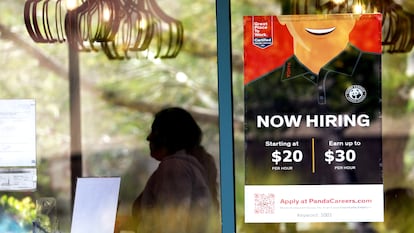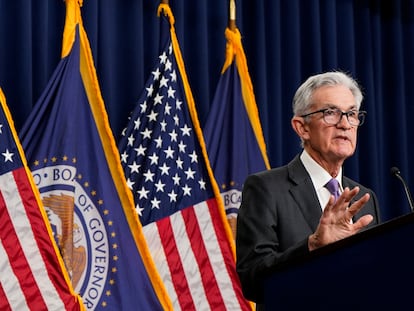US employers scaled back hiring in April: How that could let the Fed cut interest rates
The economy added 175,000 jobs in a sign that persistently high interest rates may be starting to slow the robust U.S. job market

The nation’s employers pulled back on their hiring in April but still added a decent 175,000 jobs in a sign that persistently high interest rates may be starting to slow the robust U.S. job market. Friday’s government report showed that last month’s hiring gain was down sharply from the blockbuster increase of 315,000 in March. And it was well below the 233,000 gain that economists had predicted for April.
Yet the moderation in the pace of hiring, along with a slowdown last month in wage growth, will likely be welcomed by the Federal Reserve, which has kept interest rates at a two-decade high to fight persistently elevated inflation. Hourly wages rose a less-than-expected 0.2% from March and 3.9% from a year earlier, the smallest annual gain since June 2021.
The Fed has been delaying any consideration of interest rate cuts until it gains more confidence that inflation is steadily slowing toward its 2% target. Rate cuts by the central bank would, over time, reduce the cost of mortgages, auto loans and other consumer and business borrowing.
Stock prices jumped and bond yields fell Friday after the jobs report was released on hopes that rate cuts might now be more likely sometime in the coming months.
“A slowdown in payrolls to a decent pace to start the second quarter, coupled with a slowing in wage gains, will be welcome news to (the Fed’s) policymakers,” said Rubeela Farooqi, chief U.S. economist at High Frequency Economics. “Current readings also support the view that rates cuts — and not hikes — are the base case scenario for the Fed this year.”
The state of the economy is weighing on voters’ minds as the November presidential campaign intensifies. Despite the strength of the job market, Americans remain generally exasperated by high prices, and many of them assign blame to President Joe Biden.
Even with the April hiring slowdown, last month’s job growth amounted to a solid increase, though it was the lowest monthly gain since October. With the nation’s households continuing their steady spending, many employers have had to keep hiring to meet their customer demand.
Though the unemployment rate ticked up from 3.8% to 3.9% in April, it was the 27th straight month in which the rate has remained below 4%, tying the longest such streak since the 1960s.
“Certainly a cooler jobs report than we’ve seen,” said Michael Pugliese, senior economist at Wells Fargo. “But it’s not like it was disastrous: 175,000 is still pretty strong, and unemployment below 4% is still pretty healthy.’’ He expects hiring, which averaged a vigorous 242,000 from February through April, to continue to decelerate.
Last month’s hiring was led by healthcare companies, which added 56,000 jobs. Warehouse and transportation companies added 22,000 and retailers 20,000. Government at all levels, which had been hiring aggressively, added just 8,000 jobs in April, the lowest monthly total since December 2022.
Local governments didn’t add any jobs at all last month. Paul Ashworth of Capital Economics noted that state and local government revenue has recently slumped.
Temporary help jobs fell by more than 16,000. These positions are often seen as a potential indicator of where the job market is headed because companies sometimes try out temps before committing to full-time hires.
The share of the adult population that either has a job or is looking for one was unchanged at 62.7%, well below pre-pandemic levels.
America’s job market has repeatedly proved more robust than almost anyone had predicted. When the Fed began aggressively raising rates two years ago to fight a punishing inflation surge, most economists expected the resulting jump in borrowing costs to cause a recession and drive unemployment to painfully high levels.
The Fed raised its benchmark rate 11 times from March 2022 to July 2023, taking it to the highest level since 2001. Inflation did steadily cool as it was supposed to — from a year-over-year peak of 9.1% in June 2022 to 3.5% in March.
Yet the resilient strength of the job market and the overall economy, fueled by steady consumer spending, has kept inflation persistently above the Fed’s 2% target.
The job market has been showing other signs of eventually slowing. This week, for example, the government reported that job openings fell in March to 8.5 million, the fewest in more than three years. Still, that is a large number of vacancies: Before 2021, monthly job openings had never topped 8 million, a threshold they have now exceeded every month since March 2021.
On a month-over-month basis, consumer inflation hasn’t declined since October. The 3.5% year-over-year inflation rate for March was still running well above the Fed’s 2% target.
Steven Kramer, CEO of WorkJam, an online platform that helps businesses like retailers and hospitality companies manage their hourly workers’ tasks and training, said that he is noticing that pressure to raise wages has eased. But he is seeing companies focusing more on offering flexibility in shifts for workers who are increasingly juggling multiple jobs to pay their bills in the face of still stubborn inflation. “They’re allowing workers to swap a shift or pick up a shift,” he said.
Onur Kutlubay, CEO of You Parcel, a Totowa, New Jersey-based company that provides shipping services to small e-commerce businesses, said that it’s still challenging to find skilled workers like forklift operators and supervisors, while unskilled workers are easier to find.
You Parcel has 43 workers across eight warehouse and storage facilities, most of them in New Jersey. Kutlubay said he’s had to keep increasing wages for its highly skilled employees. In 2020, skilled workers started at $16; now, hourly wages start at $25. For unskilled workers, the starting wages are now $16; in 2020, the figure was around $11.
He noted people are preferring to work as Uber drivers or work for delivery companies such as DoorDash. ”The jobs give them the opportunity to get some tips from customers,” he said. “They tend to be more attractive to people. That keeps them away from regular jobs like the ones that we have.”
Sign up for our weekly newsletter to get more English-language news coverage from EL PAÍS USA Edition
Tu suscripción se está usando en otro dispositivo
¿Quieres añadir otro usuario a tu suscripción?
Si continúas leyendo en este dispositivo, no se podrá leer en el otro.
FlechaTu suscripción se está usando en otro dispositivo y solo puedes acceder a EL PAÍS desde un dispositivo a la vez.
Si quieres compartir tu cuenta, cambia tu suscripción a la modalidad Premium, así podrás añadir otro usuario. Cada uno accederá con su propia cuenta de email, lo que os permitirá personalizar vuestra experiencia en EL PAÍS.
¿Tienes una suscripción de empresa? Accede aquí para contratar más cuentas.
En el caso de no saber quién está usando tu cuenta, te recomendamos cambiar tu contraseña aquí.
Si decides continuar compartiendo tu cuenta, este mensaje se mostrará en tu dispositivo y en el de la otra persona que está usando tu cuenta de forma indefinida, afectando a tu experiencia de lectura. Puedes consultar aquí los términos y condiciones de la suscripción digital.
More information
Archived In
Últimas noticias
Most viewed
- Sinaloa Cartel war is taking its toll on Los Chapitos
- Oona Chaplin: ‘I told James Cameron that I was living in a treehouse and starting a permaculture project with a friend’
- Reinhard Genzel, Nobel laureate in physics: ‘One-minute videos will never give you the truth’
- Why the price of coffee has skyrocketed: from Brazilian plantations to specialty coffee houses
- Silver prices are going crazy: This is what’s fueling the rally










































